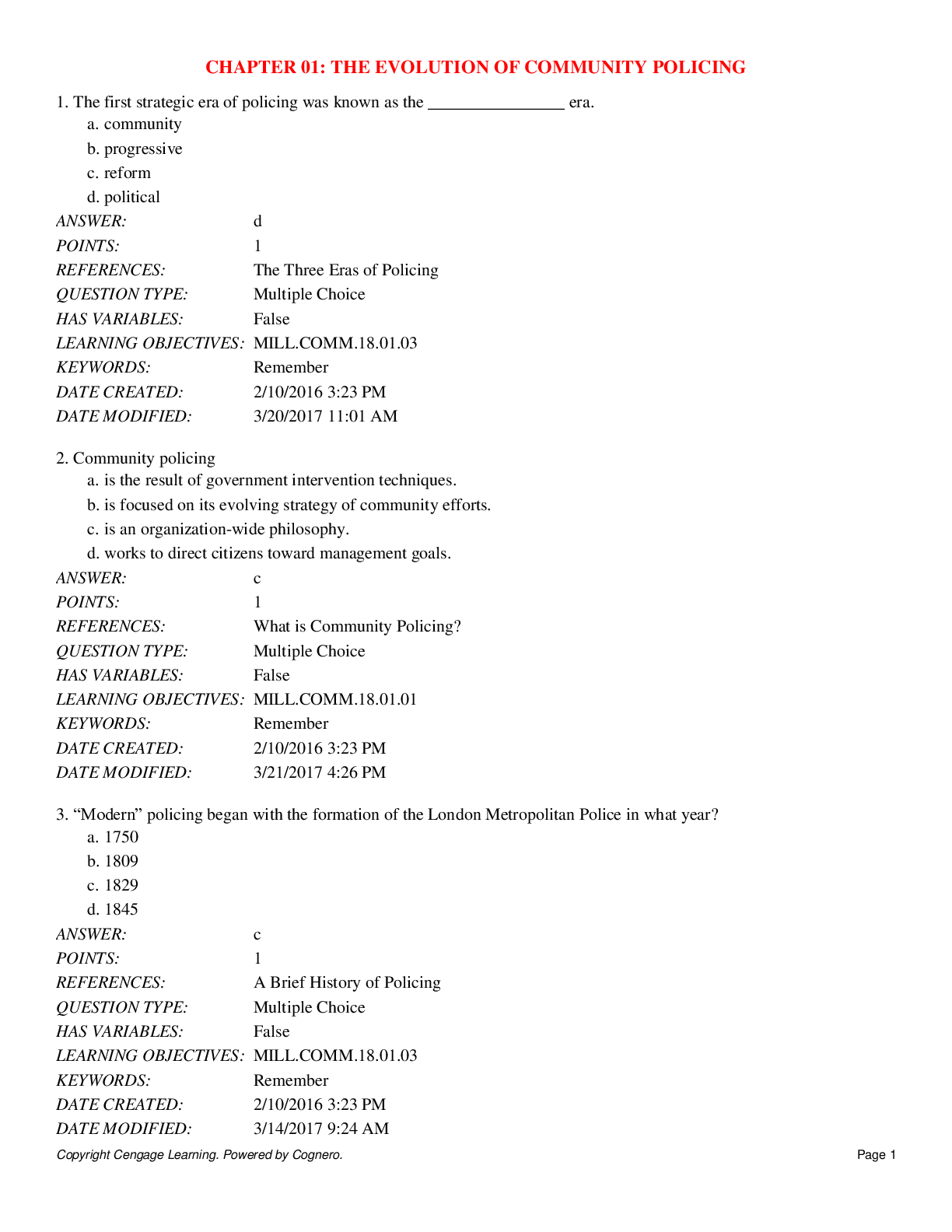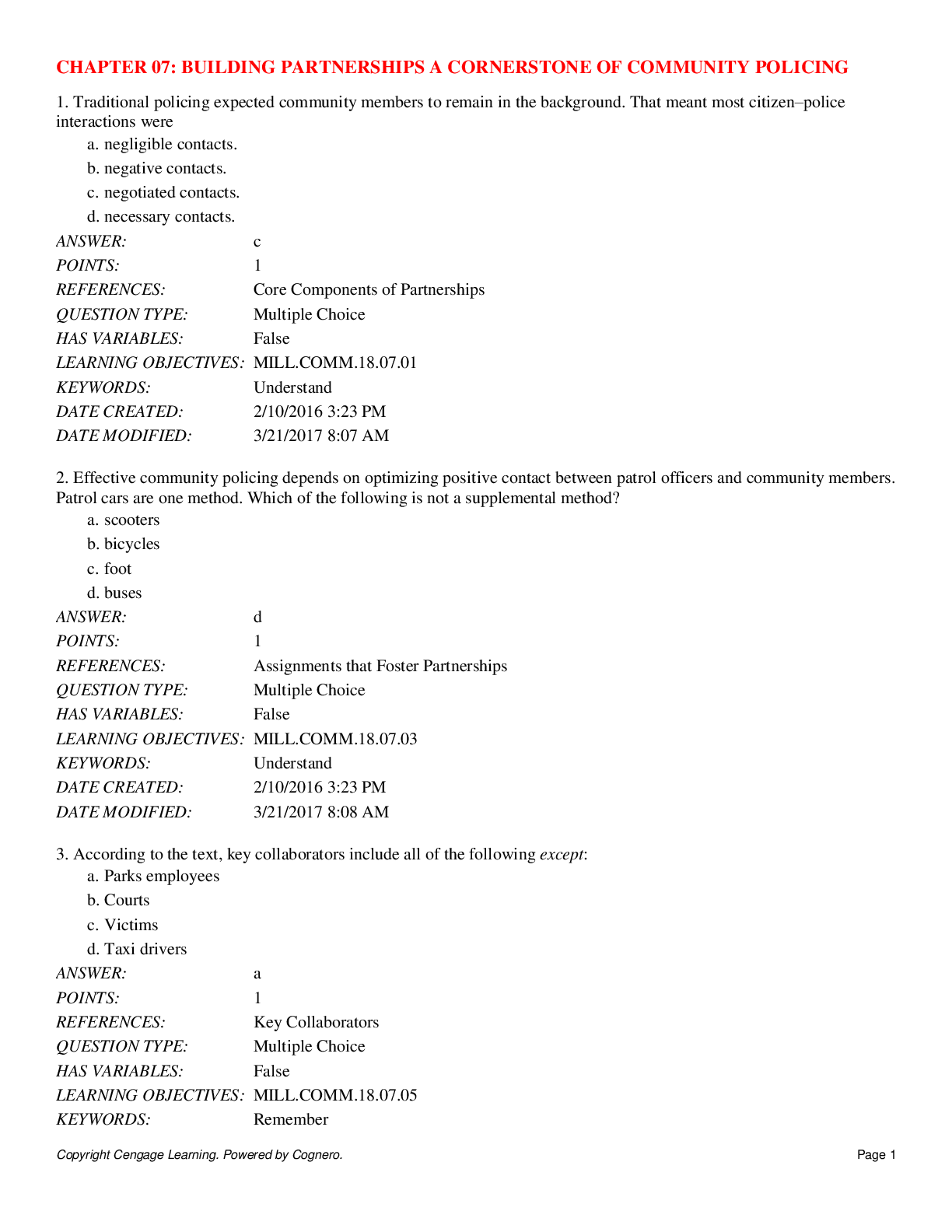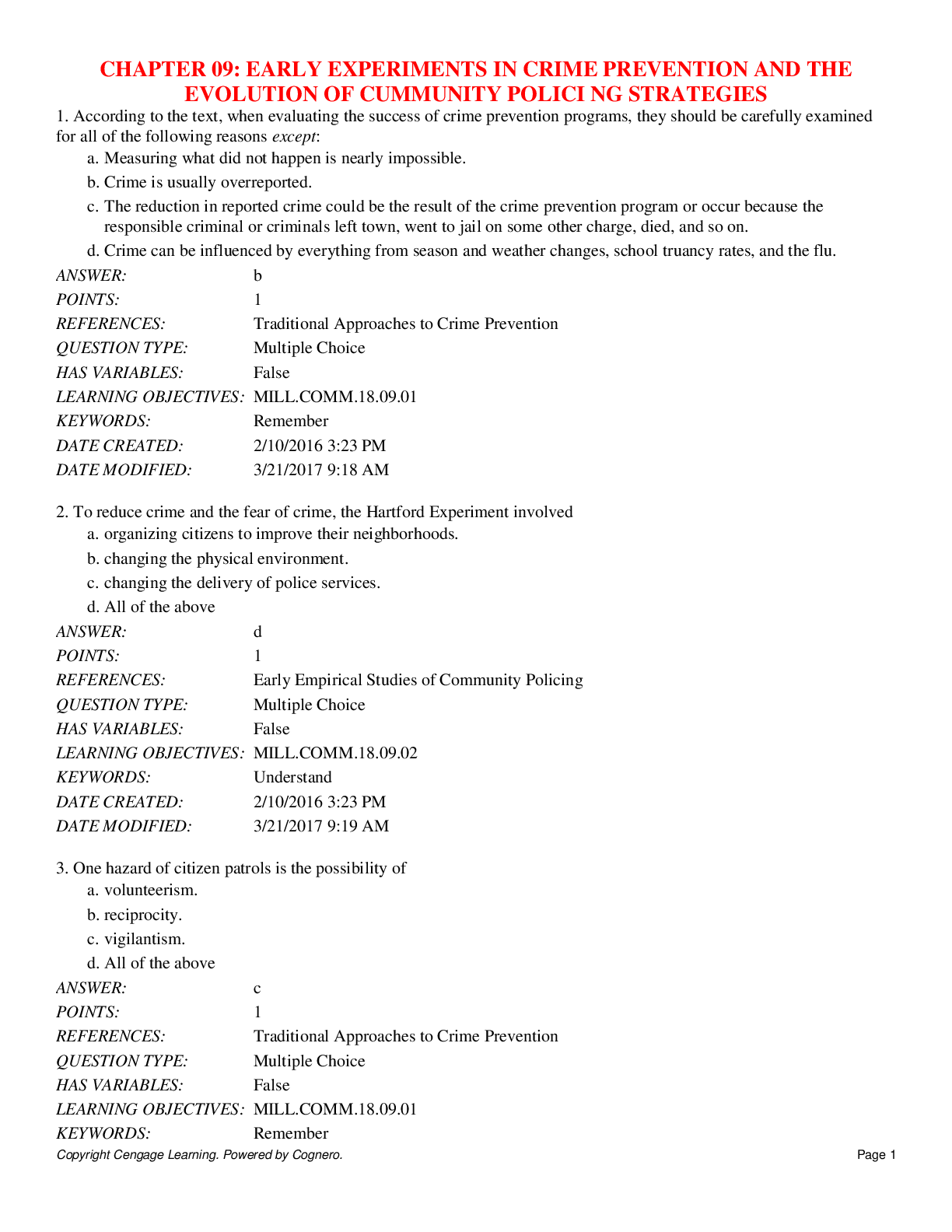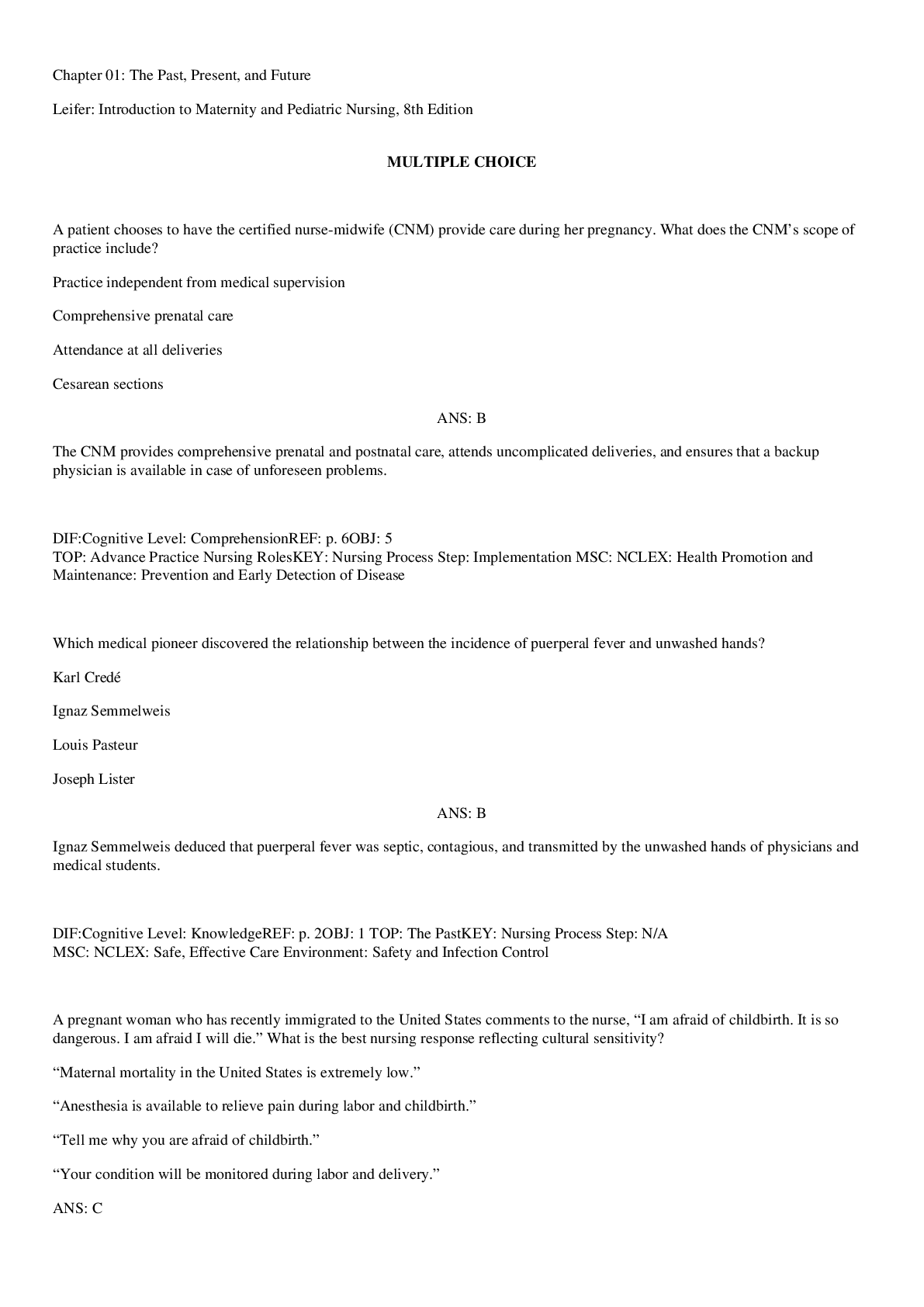Calculus > QUESTIONS & ANSWERS > CHAPTER 01: THE EVOLUTION OF COMMUNITY POLICING. All Answers. (All)
CHAPTER 01: THE EVOLUTION OF COMMUNITY POLICING. All Answers.
Document Content and Description Below
1. The first strategic era of policing was known as the ________________ era. a. community b. progressive c. reform d. political 2. Community policing a. is the result of go... vernment intervention techniques. b. is focused on its evolving strategy of community efforts. c. is an organization-wide philosophy. d. works to direct citizens toward management goals. 3. “Modern” policing began with the formation of the London Metropolitan Police in what year? a. 1750 b. 1809 c. 1829 d. 1845 4. Which of the following is considered the father of modern policing? a. Robert Peel b. August Vollmer c. Robert Palmer d. William Parker 5. Peel, when appointed as home secretary, proposed that unpaid citizen volunteers be enlisted to serve as a. police officers. b. night watch. c. street watchers. d. hue and cry callers. 6. If a watchman or any other citizen saw a crime in progress, he was expected to __________, summoning all citizens within earshot to join in pursuing and capturing the wrongdoer. a. perform the tithing b. give the hue and cry c. identify and pursue d. None of the above 7. In 1833, ____________ became the first city to pay both day and night watchmen. a. Boston b. New York c. Philadelphia d. New England 8. At the time the Metropolitan Police Force was established in London, the United States was still operating under a. a day-and-night watch system. b. the frankpledge system. c. the hue and cry system. d. the tithing system. 9. The Norman system requiring all free men to swear loyalty to the king’s law and take responsibility for maintaining the local peace is called a. the tithing system. b. the frankpledge system. c. the hue and cry system. d. the community system. 10. August Vollmer a. helped spearhead the reform movement in policing. b. helped institute the patronage system. c. helped institute the spoils system. d. Both a and b 11. The Anglo-Saxons grouped their farms around small, self-governing villages that policed themselves. This informal arrangement became more structured under which ruler? a. King Edward b. Queen Victoria c. King Alfred d. Queen Elizabeth 12. The system that required every male to enroll for police purposes in a group of 10 families was known as a. frankpledge. b. hue and cry. c. tithing. d. warden. 13. The tithing system was replaced by William the Conqueror with 55 military districts called a. home rule. b. home forts. c. shires. d. garrisons. 14. __________ is known as the father of American police professionalism. a. August Vollmer b. Darrel Gates c. William Parker d. William Bratton 15. Twentieth-century Southern law enforcement was essentially a direct outgrowth of the 19th-century a. carpetbaggers. b. slave patrols. c. Jim Crow laws. d. slave threat. 16. The requirement that police officers advise criminal suspects of their rights before custodial interrogation is required by the decision of which Supreme Court case? a. Mapp v. Ohio b. Miranda v. Arizona c. Terry v. Ohio d. Gideon v. Wainwright 17. The law that evidence gathered in an illegal search and seizure could not be used against the defendant was decided by the U.S. Supreme Court in which 1914 case? a. Weeks v. United States b. Miranda v. Arizona c. Terry v. Ohio d. Gideon v. Wainwright 18. The 1972 police research experiment that tested the effect of different levels of patrols and challenged the basic assumptions about the effect of patrol on crime was known as the a. Michigan Foot Patrol Study. b. Wickersham Commission Experiment. c. Community Policing Experiment. d. Kansas City Preventive Patrol Study. 19. Crime prevention and organization structure: Americans borrowed most of this model of modern policing from the a. military model. b. London model. c. French model. d. European model. 20. In the first quarter of the 19th century, one major component that influenced American policing was a. politics. b. incompetence. c. minorities. d. inefficiency. 21. Giving officers permanent assignments so they can get to know the citizens within their area is part of the ____________ dimension. a. philosophical b. strategic c. relative d. progressive 22. Politicians rewarding those who voted for them with jobs or special privileges was called a. the community system. b. the progressive system. c. the political system. d. the patronage system. 23. During the reform era, the police's relationship with the community they served was a. more reactive. b. exemplified by stronger communication with the public. c. professionally remote. d. an equal partnership. 24. During the reform era, the concept of ____________ developed, a phrase referring to the line that separates law-abiding, peaceful citizens from the murderous, plundering villains who prey upon them. The phrase also suggests a distance between the police and the public they serve. a. psychological distancing b. us against them c. enemy and pigs d. the thin blue line 25. Cordner’s four dimensions of community policing include all of the following except a. tactical. b. organizational. c. standardization. d. strategic. 26. According to some historians, the community era had its roots in the ______________, released in February 1968 by the President’s National Advisory Committee on Civil Disorder. a. Kerner Commission Report b. Vollmer study c. Rand Corporation study d. CID Efficiency Measures study 27. This court case, decided by the Unites States Supreme Court in 1963, required states to provide free counsel to indigent defendants in all felony cases. a. Mapp v. Ohio b. Escobedo v. Illinois c. Weeks v. United States d. Gideon v. Wainwright 28. In 1929, President Herbert Hoover appointed the National Commission on Law Observance and Enforcement (Wickersham Commission) to study a. the criminal justice system. b. juvenile delinquency. c. crime trends in the general population. d. corruption in the private business sector. 29. All of these are essential elements of community policing except: a. Partnerships. b. Problem solving. c. Organizational change. d. All are elements of community policing. 30. Peele’s ____ principles became the basis for “modern” police forces. a. 7 b. 8 c. 9 d. 10 31. Which of the following was not a right of southern police forces in the pre-Civil Rights South? a. They could enter slaves dwellings without due cause. b. They could put slaves to death for violating the slave code. c. They could punish slaves from outside their plantation. d. They could sell runaway slaves they caught. 32. The reform era was also known as the ________ era. a. progressive b. patronage c. political d. professional 33. The image of the “Keystone Cops” during the Political Era depicted police as a. upright citizens. b. clumsy bunglers. c. corrupt potiticians. d. astute detectives. 34. Which of the following is not an innovation introduced to policing by August Vollmer? a. Radios in patrol cars b. A police school c. A handwriting classification system d. A comprehensive policing manual of legal decisions effecting policing. 35. Which of the following was not a factor that led to the police being viewed as the “enemy” in the 1960s in America? a. The antiwar movement b. The Civil Rights movement c. The Women’s Rights movement d. An emerging drug-using counterculture 36. _________ was established after the assassinations of Martin Luther King Jr. and Robert Kennedy to address civil unrest and establish justice and domestic tranquility. a. The National Advisory Commission on Civic Disorders b. The National Commission on the Causes and Prevention of Violence c. The President’s commission on Law Enforcement and Administration d. The National Advisory Commission on Criminal Justice Standards and Goals 37. Which of the following is not one of the four general priciples that define community policing? a. problem solving b. organizational transformation c. reactive crime prevention d. community engagement 38. Skolnick and Bayley (1988) described four internationally recurring elements of community policing. Which of the following elements was not listed in their study? a. Community-based crime prevention b. Increased olice accountability c. The reorientation of patrol activities d. A strong central command force 39. The _______ dimension translates the two other dimensions into concrete programs and practices. a. philosophical b. tactical c. organizational d. strategic 40. August Vollmer and O.W. Wilson are credited with spearheading the “reform movement,” which called for a drastic change in the organization and function of police departments. a. True b. False 41. Community policing is a philosophy that promotes organization strategies, which supports the systematic use of partnerships and problem-solving techniques. a. True b. False 42. Community policing is a philosophy of full-service, personalized policing, where the same officer patrols and works in the area on a permanent basis from a decentralized place, working in a proactive partnership with citizens to identify and solve problems. a. True b. False 43. The London Police was founded by Sir Robert Palmer. a. True b. False 44. The requirement that police officers advise criminal suspects of their rights before custodial interrogation is required by the decision in the 1961 U.S. Supreme Court case of Mapp v. Ohio. a. True b. False 45. The Kansas City Preventive Patrol Study found that increased patrol reduced crime and had a significant effect on public awareness about police presence. a. True b. False 46. Community policing is an organizational strategy that emerged in the 1980s and 1990s for dramatically improving the delivery of police services. a. True b. False 47. According to the text, the earliest record of an ancient society’s need for rules to control human behavior dates back to 640 CE. a. True b. False 48. Every Southern state had slave patrols that formally required all Black men to serve as patrollers. a. True b. False 49. Community policing is one of the most significant trends in policing history. a. True b. False 50. Community policing is a philosophy that can be translated into practice in as many ways as there are communities. a. True b. False 51. One of the four general principles that define community policing is community engagement. a. True b. False 52. Police officer uniforms were successfully introduced at the same time the first U.S. police forces were established. a. True b. False 53. During the reform era, the police sought to reestablish a close relationship with the community. a. True b. False 54. According to the text, team policing, community resource officers, and school liaison officers are part of public relations. a. True b. False 55. Community policing is a philosophy of full-service, _______________ policing where the same officer patrols and works in the area on a permanent basis from a decentralized place. 56. 2300 BCE is the date of the earliest record of an ancient society’s rules to control human behavior when ___________ rulers codified their concept of offenses against society. 57. The Anglo-Saxons grouped their farms around small, self-governing villages that policed themselves. This informal arrangement required every male to enroll for police purposes in a group of 10 families, which is known as a __________. 58. During the 1960s and early 1970s, considerable turmoil existed throughout the country related to issues of police and race relations, corruption, and use of force. During that period, according to Walker and Macdonald (2009), five national ___________________, or ad hoc, short-term investigations of law enforcement, were initiated. 59. Modern policing began in 1829 with the formation of the London Metropolitan Police, founded by______________. 60. During the ___________ era the police were decentralized under the authority of the municipality in which they worked. 61. A ___________________ shift is a new way of thinking about a specific subject. 62. Whereas traditional policing has been reactive, responding to calls for service, community policing is ____________, anticipating problems and seeking solutions to them. 63. According to some historians, the community era had its roots in the ___________________________, released in February 1968 by the President’s National Advisory Committee on Civil Disorder. 64. When the police separate the law-abiding, peaceful citizens from the murderous, plundering villains who prey upon them, this is called the ____________________________________. [Show More]
Last updated: 1 year ago
Preview 1 out of 22 pages
Instant download

Buy this document to get the full access instantly
Instant Download Access after purchase
Add to cartInstant download
Reviews( 0 )
Document information
Connected school, study & course
About the document
Uploaded On
Jan 15, 2020
Number of pages
22
Written in
Additional information
This document has been written for:
Uploaded
Jan 15, 2020
Downloads
0
Views
190





















